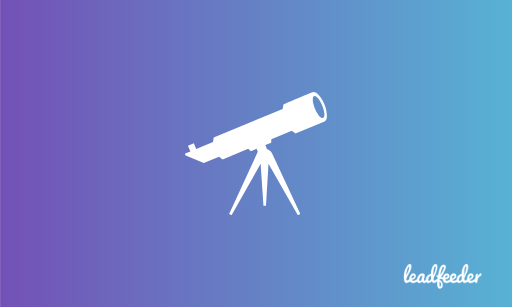You already know that spray-and-pray sales prospecting doesn't work.
To be effective, your prospecting process needs to be targeted.
Here's the thing most salespeople don't realize: Targeted prospecting isn't just a tactic you can plug into your sales process—it's an end-to-end strategy.
When targeted prospecting is treated as another box to tick, sales teams spread themselves too thin by selling to prospects who aren't a great fit.
The good news? There's a better way.
It's not enough to say, "Your prospects should be targeted." You need a process that makes it happen.
Note: Want to better understand the journey customers take from prospect to closed sale? Sign up and give Leadfeeder a try—free for 14 days.
Why targeted prospecting is more effective than traditional sales prospecting
More than 40 percent of sales reps say that sales prospecting is the most challenging part of the process. It's not hard to see why.
The average B2B company grows its revenue and customer base by talking to as many potential customers as possible.
More=better, right?
The more prospects you talk to, the theory goes, the more customers you can close.

The problem is, that time you spent getting to know one (crappy) prospect is time you don’t have to spend on prospects that might close.
Rather than having a larger prospect list, sales targeting allows you to focus more time on customers that might actually buy.
Here are a few other benefits of targeted prospecting:
Provide prospects with a better experience: When you have more time to focus on each candidate, you get to know prospects better and can provide a more personalized experience.
Higher close rates: Focusing on high-value prospects means fewer low-value prospects that drag down close rates.
Higher customer retention rates: Prospecting is the start of your customer relationships. When future customers feel valued from the start, they are less likely to churn.
More up-selling and cross-selling opportunities: Targeted prospecting provides a deeper understanding of each customer's needs and so you can offer other solutions they actually need.
The bottom line is this: targeted prospecting allows sales teams to spend more time on what matters, resulting in a more effective — and scalable— sales process.
How to target sales prospects
A truly targeted prospecting strategy starts from the ground up. It focuses on reaching the right people at the right time, on the right channel, and knowing exactly what to say. Here is a four-step process for creating a customer-focused prospecting process.
Step 1: Get a clear picture of your target prospects
How do prospects end up on your list? Because they tick the right box for annual revenue or their business is in the right industry? Maybe they happen to have the right title?
Generic information doesn't tell you who they are or what challenges they face.

Salespeople need more context about prospects’ business and needs. Without context, your messaging will be generic and ineffective.
So, how do you improve your qualification process? Here are a few ways:
Talk to customer support teams to understand the qualities your best customers share.
Use a sales prospecting tool to dive deeper into prospects.
Create one (or more) prospect personas and plan targeting strategies based on what types of messaging they respond to.
Remember, a better qualification process means sales reps only reach out to only those most likely to need your solution.
This means you have more time to refine your sales approach instead of throwing out one-size-fits-all tactics and trying to appeal to 10,000 different prospects.
Step 2: Start with a smaller, more targeted prospecting list
The traditional approach to sales prospecting says that the bigger your initial list of prospects, the more customers you'll convert.

A larger, less qualified list automatically means your messaging is less targeted. With 10,000 prospects, you might get a hold of 100 of them. But with a list of 250, you might reach half of them--and they are far more likely to convert.
Start by honing in on the best-fit prospects and spending time talking to them—instead of trying to convince prospects who aren’t a good fit.
Here are a few ways to find more targeted prospect lists:
Partner with complementary brands
The prospect persona you put together in step one should give you a clear idea of what brands your prospects might work with. Use that information to partner with related brands, sharing prospect lists, and use each other to get a foot in the door.
Sponsor and attend conferences
Conference attendees are often already semi-qualified for you. You know their industry and interests—and it’s no secret that they’re an excellent place to meet with prospects. Take it a step further by sponsoring relevant conferences, granting full access to information and contact information.
While in-person events are on hold, consider hosting a webinar or sponsoring virtual conferences in your industry.
Use a sales prospecting tool
Leadfeeder and other sales prospecting tools help you understand prospects by showing you which companies visit your site, including in-depth information on company size and revenue, and contact information.
You can also see how prospects behave on your website, such as:
Which pages do they visit?
How long do they spend there?
Did more employees from the company visit after you gave a demo?
Step 3: Build your sales prospecting process around customers
The typical sales process is all about moving prospects forward toward a sale and focusing on specific KPIs salespeople are supposed to hit.
There’s a tendency to think, "I just need to do so many things today, and my job is done." For example, you might want to:
Email ‘X’ number of prospects today
Schedule ‘Y’ number of calls
Book ‘Z’ number of demos
When that’s the basis of your prospecting process, it leads to unnatural and forced messaging that doesn't convert.
This type of process isn't designed to meet prospects where they are in the buying journey—it’s designed to push them to close.
That can translate into making prospects jump through hoops of your own design.
Instead, use a holistic approach and build the entire sales process around the natural behaviors prospects were already taking.
Then, it's less about how qualified prospects are and more about the behaviors they exhibit.
Focus on creating opportunities by understanding the context underlying each prospect’s interest in your product. The best prospecting system focuses on enabling your sales team to know when to reach out and what to say.
Step 4: Banish generic outreach
We’ve all seen emails riddled with CTAs and rambling messaging that ends with something like, “Does this apply to you?”

When you send the same generic message to 10,000 prospects, your outreach will always be less effective.
A well-targeted prospecting strategy should lead SDRs to the right messaging and CTA for the decision-maker persona you are prospecting to.
This is what happens when prospects are qualified based on broad traits rather than experiences or behaviors.
When your prospects qualify because of their experiences--such as actions they take on your site or other behavioral data, it's easy to speak to their challenges and needs.
You’ve done the upfront work of getting to know your prospects inside and out, along with building smaller, targeted lists of those people, so there’s no reason to send broad messages.
You should be well-equipped with a targeted message that includes the action you’re asking prospects to take.
Final thoughts on targeted sales prospecting
We know that spray-and-pray sales prospecting just doesn’t work, but there’s a lot of gray area between traditional prospecting and an end-to-end targeted prospecting strategy.
If your process falls somewhere in that middle area, use the tips above to build a strong, targeted sale approach. Focus on a smaller, more qualified list and build a sales prospecting process based on customer behavior, not just sales rep metrics.
You will be happier, and so will your prospects.
Note: Try your hand at sales prospecting with new leads from Leadfeeder. Our 14-day free trial will do the trick.
Now that you're here
Leadfeeder is a tool that shows you companies that visit your website. Leadfeeder generates new leads, offers insight on your customers and can help you increase your marketing ROI.
If you liked this blog post, you'll probably love Leadfeeder, too.
Sign up









